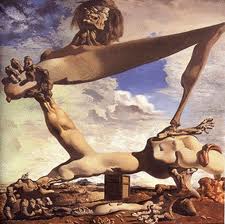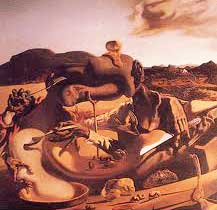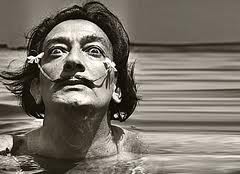Construcción blanda con judías hervidas
'Construcción blanda con judías hervidas' (Soft Construction with Boiled Beans), whose subtitle is 'Premonición de la guerra civil' (Premonition of the Civil War), is a Surrealist Spanish painting produced by Salvador Dalí in 1936.
The Painting

'Construcción blanda con judías hervidas' is a canvas that was painted using oil paints in Salvador Dalí's characteristic Surrealist style. It measures 1 metre in height by 0.99 metres in width.
The painting features many gruesome images and is considered to be one of the most aggressive depictions of the Spanish Civil War. In the picture, it appears that there are two main figures in the painting which appear as giants compared to the surrounding landscape. The main figure, in the top half of the painting, consists in a leg which extends to the right hand side of the painting and then drops down to be ended with a skeletal foot. At the left hand side of the painting is the other body part of the creature which looks like a woman's breast. In the middle of this creature sits a grotesque human head which is extremely demon-like. Dalí once said that this head was inspired by the demonic face of the God Saturn in Francisco Goya's painting, 'El Saturno devorando a un hijo' (Saturn Devouring his Son).
The second figure, underneath the first, appears to be lying on its back, with its featureless head, supported by an ownerless foot, on the right hand side of the painting. The body of this creature splits into two arms at the left hand side of the painting. One of the arms is reaching upwards, grasping the breast of the first creature. The other arm is lying on the ground with an unclenched hand.

The two figures are therefore locked together in what appears to be an endless and horrific battle. This image has therefore been interpreted as Spain attacking and harming itself during the Spanish Civil War that followed in the period after this painting was complete.
The background of the 'Construcción blanda con judías hervidas' is a barren, desert-like landscape, painted in rich yellows, oranges and browns, with only a few small Spanish-like towns and buildings visible in the distance. It is thought that the landscape is meant to be that of Dalí's local region of Cadaqués, to the North East of Barcelona. The sky however is a fantastic blue and full of swirling, almost impressionistic, clouds. In the bottom left hand corner there is a small man appearing from just behind the second creature's hand. Art historians believe this is a representation of the spirits Dalí believed were inside the souls of some his childhood friends.
The 'judías hervidas' (boiled beans) mentioned in the title are not the main feature of the painting but they do appear dotted around. They can mostly be found on the ground in the centre of the painting as well as a couple on the creatures themselves. Beans were a frequent image used by Dalí in order to represent nutrition. Here however they are probably more likely to refer to the ancient Catalan custom of offering beans to the Gods. Salvador Dalí often entitled his paintings with objects that were not the main focus of the painting and that were hard to find his paintings.
History

'Construcción blanda con judías hervidas' was painted by Dalí six months before the start of the Spanish Civil War in 1936 and is therefore worthy of its subtitle which it acquired later. The painting is therefore a depiction of the horror of war and how it can be self-mutilating. It has therefore become to be an anti-war symbol similar to the status of Picasso's 'Guernica'.
'Construcción blanda con judías hervidas' is one of many paintings in which Salvador Dalí addressed the issue of the Spanish Civil War, although this painting is without doubt the most famous and the most impressive. Today the painting can be seen at the Philadelphia Museum of Art, where it has resided since 1950.
